Typomorphic Features and Source of Native Gold from the Sykhoi Log Area Placer Deposits, Bodaibo Gold-Bearing District, Siberia, Russia
Abstract
1. Introduction
2. Geology and Metallogeny of Bodaibo Gold-Bearing District
2.1. Geological Structure, Stratigraphy and Metallogeny of Pre-Cenozoic Stage
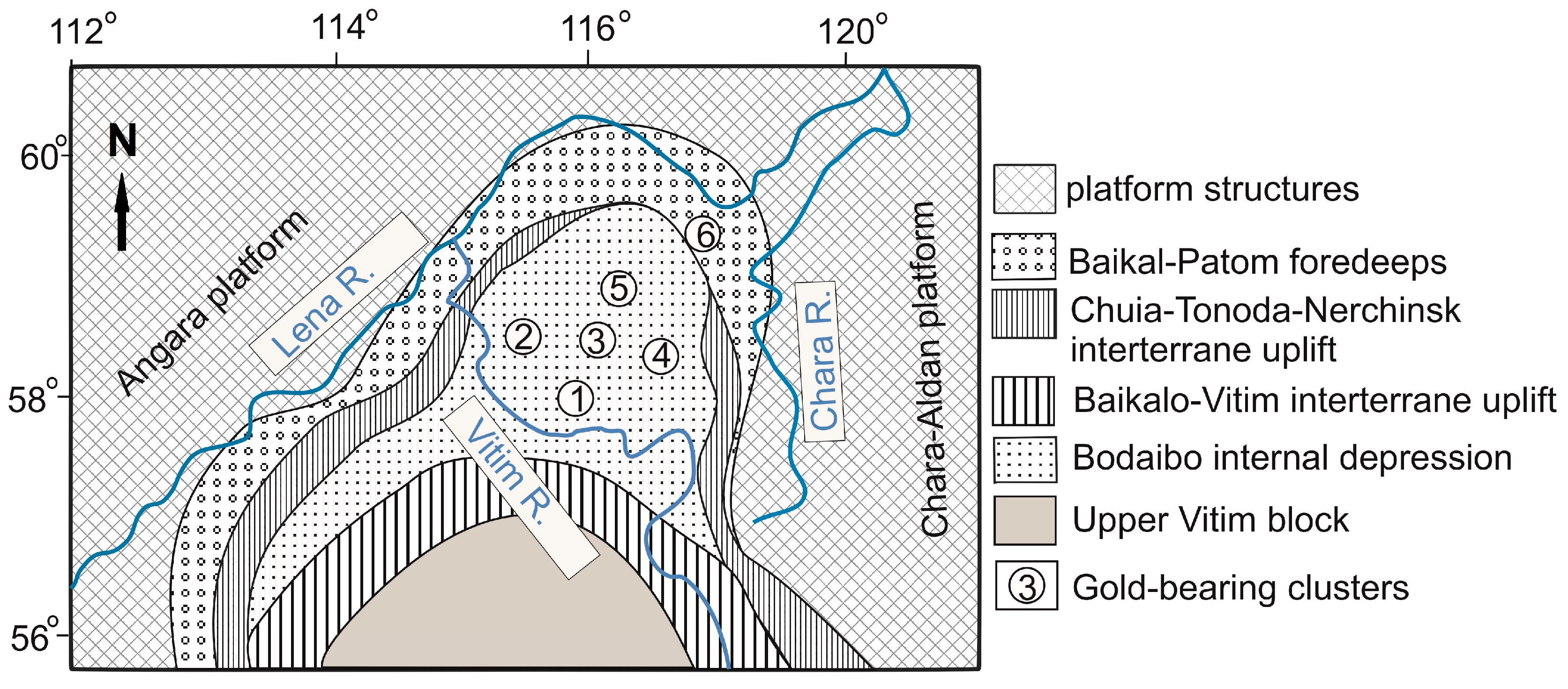
2.2. Sukhoi Log Deposit
2.3. The Structure and Composition of The Sedimentary Cover and Placer Deposits of The Bodaibo District
3. Sample Collection and Analysis
4. Results
4.1. Gold Particle Size and Morphology
4.2. Gold Alloy Composition
4.3. Mineral Inclusion
4.4. Gold-Rich Rims
4.5. Main Types of Native Gold
5. Discussion
5.1. Sources of the Placer Gold
5.2. Evidence for Transformation of Native Gold in Supergenic Conditions and Features of This Process
5.3. Origin of Gold-Rich Rims
5.4. Perspectives of Discovering of New Placers in Bodaibo District
6. Conclusions
Author Contributions
Funding
Data Availability Statement
Acknowledgments
Conflicts of Interest
References
- Smirnov, V.I. Ore Deposits of the USSR; Pitman Publishing: London, UK, 1977; Volume II, p. 424. [Google Scholar]
- Lalomov, A.V.; Vladimirova, O.V.; Bochneva, A.A. The role of placer deposits in the gold mining industry of Russia. Gold Tech. 2022, 4, 36–45. (In Russian) [Google Scholar]
- Chugaev, A.V.; Budyak, A.E.; Larionova, Y.O.; Chernyshev, I.V.; Travin, A.V.; Tarasova, Y.I.; Gareev, B.I.; Batalin, G.A.; Rassokhina, I.V.; Oleinikova, T.I. 40Ar-39Ar and Rb-Sr age constraints on the formation of Sukhoi-Log-style orogenic gold deposits of the Bodaibo District (Northern Transbaikalia, Russia). Ore Geol. Rev. 2022, 144, 104855. [Google Scholar] [CrossRef]
- Bochneva, A.A.; Lalomov, A.V.; LeBarge, W. Placer mineral deposits of Russian Arctic zone: Genetic prerequisites of formation and prospect of development of mineral resources. Ore Geol. Rev. 2021, 138, 104349. [Google Scholar] [CrossRef]
- Gavrilov, A.M.; Kryazhev, S.G. Mineralogy and geochemistry of ore at the Sukhoi Log deposit. Razved. Okhrana Nedr. 2008, 8, 3–16. (In Russian) [Google Scholar]
- Yudovskaya, M.A.; Distler, V.V.; Prokof’ev, V.Y.; Akinfiev, N.N. Gold mineralisation and orogenic metamorphism in the Lena province of Siberia as assessed from Chertovo Koryto and Sukhoi Log deposits. Geos. Front. 2016, 7, 453–481. [Google Scholar] [CrossRef]
- Goldfarb, R.J.; Groves, D.I.; Gardoll, S. Orogenic gold and geologic time: A global synthesis. Ore Geol. Rev. 2001, 18, 1–75. [Google Scholar] [CrossRef]
- Goryachev, N.; Pirajno, F. Gold deposits and gold metallogeny of Far East Russia. Ore Geol. Rev. 2014, 59, 123–151. [Google Scholar] [CrossRef]
- Safonov, Y.G. Gold and gold-bearing deposits of the world: Genesis and metallogenic potential. Geol. Ore Depos. 2003, 45, 265–278. [Google Scholar]
- Safonov, Y.U.G.; Popov, P.P.; Volkov, A.V.; Zlobina, T.M.; Chaplygin, I.V. Topical problems of gold metallogeny. Russ. Geol. Geophys. 2007, 48, 977–991. [Google Scholar] [CrossRef]
- Dutova, E.M.; Bukaty, M.B.; Nevol’ko, A.I.; Pokrovsky, D.S.; Shvartsev, S.L. Hydrogenic concentration of gold in alluvial placers of the Egor’evskoe area (Salair). Russ. Geol. Geophys. 2006, 47, 364–376. [Google Scholar]
- Roslyakov, N.A.; Kirillov, M.V.; Morozova, N.S.; Zhmodik, S.M.; Kalinin, Y.u.A.; Nesterenko, G.V.; Roslyakova, N.V.; Belyanin, D.K.; Kolpakov, V.V. Unconventional gold placers of the China tectonic depression (Vitim Plateau, East Siberia). Russ. Geol. Geophys. 2013, 54, 483–494. [Google Scholar] [CrossRef]
- Nesterenko, G.V.; Zhmodik, S.M. Alluvial gold placers directly related to primary sources: An important forecast criterion. Dokl. Earth Sci. 2014, 455, 481–484. [Google Scholar] [CrossRef]
- Fernández-Lozano, J.; Blanco-Sánchez, J.A.; García-Talegón, J.; Franco, P. Rubefaction process as prospection criteria within the roman goldmining context of the Eria Gold Mining District (León, NW Spain). Geo-Temas 2016, 16, 371–374. [Google Scholar]
- Distler, V.V.; Yudovskaya, M.A.; Mitrofanov, G.L.; Prokof’ev VYu Lishnevskii, E.M. Geology, composition, and genesis of the Sukhoi Log noble metals deposit, Russia. Ore Geol. Rev. 2004, 24, 7–44. [Google Scholar] [CrossRef]
- Buryak, V.A.; Khmelevskaya, N.M. Sukhoi Log—One of the Largest World Gold Deposits; Dalnauka: Vladivostok, Russia, 1997; p. 156. (In Russian) [Google Scholar]
- Wood, B.L.; Popov, N.P. The giant Sukhoi Log gold deposit, Siberia. Russ. Geol. Geophys. 2006, 47, 315–341. [Google Scholar]
- Laverov, N.P.; Chernyshev, I.V.; Chugaev, A.V.; Bairova, E.D.; Golzman YuVDistler, V.V.; Yudovskaya, M.A. Formation stages of the large-scale noble metal mineralisation in the Sukhoi Log deposit, East Siberia: Results of isotope-geochronological study. Dokl, Earth Sci. 2007, 415, 236–241. [Google Scholar] [CrossRef]
- Yakubchuk, A.; Stein, H.; Wilde, A. Results of pilot Re–Os dating of sulphides from the Sukhoi Log and Olympiada orogenic gold deposits, Russia. Ore Geol. Rev. 2014, 59, 21–28. [Google Scholar] [CrossRef]
- Lishnevsky, E.N.; Distler, V.V. Deep structure of the earth’s crust in the district of the Sukhoi Log gold-platinum deposit (Eastern Siberia, Russia) based on geological and geophysical data. Geol. Ore Depos. 2004, 46, 76–90. [Google Scholar]
- Kazakevich, Y.P.; Reverdatto, M.V. Lena Gold-Bearing Region: Geology of Cenozoic Sequence and Types of Gold Placers; Nedra: Moscow, Russia, 1972; p. 152. (In Russian) [Google Scholar]
- State report. On the State and Use of Mineral and Raw Minerals Resources of the Russian Federation in 2019; VIMS-TSNIGRI: Moscow, Russia, 2020; p. 494. (In Russian) [Google Scholar]
- Large, R.R.; Maslennikov, V.V.; Robert, F.; Danyushevsky, L.V.; Chang, Z. Multistage sedimentary and metamorphic origin of pyrite and gold in the Giant Sukhoi Log Deposit, Lena Gold Province, Russia. Econ. Geol. 2007, 102, 1233–1267. [Google Scholar] [CrossRef]
- Chapman, R.J.; Mortensen, J.K. Application of microchemical characterization of placer gold grains to exploration for epithermal gold mineralization in regions of poor exposure. J. Geochem. Explor. 2006, 91, 1–26. [Google Scholar] [CrossRef]
- Dill, H.G.; Klosa, D.; Steyer, G. The Donauplatin: Source rock analysis and origin of a distal fluvial Au-PGE placer in Central Europe. Mineral. Petrol. 2009, 96, 141–161. [Google Scholar] [CrossRef]
- Dill, H.G. Gems and Placers—A Genetic Relationship Par Excellence. Minerals 2018, 8, 470. [Google Scholar] [CrossRef]
- Chapman, R.; Torvela, T.; Savastano, L. Insights into Regional Metallogeny from Detailed Compositional Studies of AlluvialGold: An Example from the Loch TayArea, Central Scotland. Minerals 2023, 13, 140. [Google Scholar] [CrossRef]
- Chapman, R.J.; Leake, R.C.; Moles, N.R.; Earls, G.; Cooper, C.; Harrington, K.; Berzins, R. The application of microchemical analysis of gold grains to the understanding of complex local and regional gold mineralization: A case study in Ireland and Scotland. Econ. Geol. 2000, 95, 1753–1773. [Google Scholar]
- Chapman, R.J.; Mortensen, J.K. Characterization of Gold Mineralization in the Northern Cariboo Gold District, British Columbia, Canada, Through Integration of Compositional Studies of Lode and Detrital Gold with Historical Placer Production: A Template for Evaluation of of orogenic gold districts. Econ. Geol. 2016, 111, 1321–1345. [Google Scholar]
- dos Santos Alves, K.; Barrios S’anchez, S.; G´omez Barreiro, J.; Merinero Palomares, R.; Compaña Prieto, J.M. Morphological and compositional analysis of alluvial gold: The Fresnedoso gold placer (Spain). Ore Geol. Rev. 2020, 121, 103489. [Google Scholar] [CrossRef]
- Fominykh, P.A.; Nevolko, P.A.; Svetlitskaya, T.V.; Kolpakov, V.V. Native gold from the Kamenka-Barabanovsky and Kharuzovka alluvial placers (Northwest Salair Ridge, Western Siberia, Russia): Typomorphic features and possible bedrock sources. Ore Geol. Rev. 2020, 126, 103781. [Google Scholar] [CrossRef]
- Liu, H.; Beaudoin, G.; Makvandi, S.; Jackson, S.E.; Huang, X. Multivariate statistical analysis of trace element compositions of native gold from orogenic gold deposits: Implication for mineral exploration. Ore Geol. Rev. 2021, 131, 104061. [Google Scholar] [CrossRef]
- Liu, H.; Beaudoin, G. Geochemical signatures in native gold derived from Au-bearing ore deposits. Ore Geol. Rev. 2021, 132, 104066. [Google Scholar] [CrossRef]
- Masson, F.-X.; Beaudoin, G.; Laurendeau, D. Quantification of the morphology of gold grains in 3D using X-ray microscopy and SEM photogrammetry. J. Sediment. Res. 2020, 90, 286–296. [Google Scholar] [CrossRef]
- McClenaghan, M.B. Overview of common processing methods for recovery of indicator minerals from sediment and bedrock in mineral exploration. Geochem. Explor. Environ. Anal. 2011, 11, 265–278. [Google Scholar] [CrossRef]
- Svetlitskaya, T.V.; Nevolko, P.A. Au-Pb compounds in nature: A general overview and new evidence from the Inagli Pt–Au placer deposit, the Aldan Shield, Russia. Ore Geol. Rev. 2017, 89, 719–730. [Google Scholar] [CrossRef]
- Gerasimov, B.; Beryozkin, V.; Kravchenko, A. Typomorphic Features of Placer Gold from the Billyakh Tectonic Melange Zone of the Anabar Shield and Its Potential Ore Sources (Northeastern Siberian Platform). Minerals 2020, 10, 281. [Google Scholar] [CrossRef]
- Rasmussen, K.L.; Mortensen, J.K.; Falck, H. Morphological and compositional analysis of placer gold in the South Nahanni River drainage, Northwest Territories. Yukon Geol. Surv. 2006, 237–250. [Google Scholar]
- Chapman, R.J.; Mortensen, J.K.; LeBarge, W. Styles of lode gold mineralization contributing to the placers of the Indian River and Black Hills Creek, Yukon Territory, Canada as deduced from microchemical characterization of placer gold grains. Miner. Deposita 2011, 46, 881–903. [Google Scholar] [CrossRef]
- Townley, B.K.; H´erail, G.; Maksaev, V.; Palacios, C.; de Parseval, P.; Sepulveda, F.; Orellana, R.; Rivas, P.; Ulloa, C. Gold grain morphology and composition as an exploration tool: Application to gold exploration in covered areas. Geochem. Explor. Environ. Anal. 2003, 3, 29–38. [Google Scholar] [CrossRef]
- Youngson, J.H.; Craw, D. Variation in Placer Style, Gold Morphology, and Gold Particle Behavior Down Gravel Bed-Load Rivers: An Example from the Shotover/Arrow-Kawarau-Clutha River System, Otago, New Zealand. Econ. Geol. 1999, 94, 615–634. [Google Scholar] [CrossRef]
- Vikentyev, I.V. Invisible and microscopic gold in pyrite: Methods and new data for massive sulphide ores of the Urals. Geol. Ore Depos. 2015, 57, 237–265. [Google Scholar] [CrossRef]
- Chapman, R.J.; Mortensen, J.K.; Crawford, E.C.; LeBarge, W. Microchemical studies of placer and lode gold in the Klondike District, Yukon, Canada: 1. Evidence for a small, gold-rich, orogenic hydrothermal system in the Bonanza and Eldorado creeks. Econ. Geol. 2010, 105, 1369–1392. [Google Scholar] [CrossRef]
- Youngson, J.H.; Wopereis, P.; Kerr, L.S.; Craw, D. Au–Ag–Hg and Au–Ag alloys in Nokomai and Nevis valley placers, northern Southland and Central Otago, New Zealand, and their implications for placer-source relationships. N. Z. J. Geol. Geophys. 2002, 45, 53–69. [Google Scholar] [CrossRef]
- Chapman, R.J.; Banks, D.A.; Styles, M.T.; Walshaw, R.D.; Piazolo, S.; Morgan, D.J.; Grimshaw, M.R.; Spence-Jones, C.P.; Matthews, T.J.; Borovinskaya, O. Chemical and physical heterogeneity within native gold: Implications for the design of gold particle studies. Miner. Depos. 2021, 56, 1563–1588. [Google Scholar] [CrossRef]
- Lalomov, A.V.; Chefranov, R.M.; Naumov, V.A.; Naumova, O.B.; Lebarge, W.; Dilly, R.A. Typomorphic features of placer gold of Vagran cluster (the Northern Urals) and search indicators for primary bedrock gold deposits. Ore Geol. Rev. 2017, 85, 321–335. [Google Scholar] [CrossRef]
- Groen, J.C.; Craig, J.R.; Rimstidt, J.D. Gold-rich rim formation on electrum grains in placers. Can. Mineral. 1990, 28, 207–228. [Google Scholar]
- McTaggart, K.C.; Knight, J. Geochemistry of Lode and Placer Gold of the Cariboo District, BC; British Columbia Ministry of Energy, Mines and Petroleum Resources: Victoria, BC, Canada, 1993; 30, p. 25.
- Arehart, G. Characteristics and origin of sediment-hosted disseminated gold deposits: A review. Ore Geol. Rev. 1996, 11, 383–403. [Google Scholar] [CrossRef]
- Laznicka, P. Geological Studies Related to the Origin and Evolution of the Witwatersrand Basin and Its Mineralization by Members and Collaborators of Econ. Geol. Res. Unit, Univ. Witwatersrand. Special Issue of the South African Journal of Geology, Vol. 93 (1), 1990. Johannesburg, 309 pp. Ore Geology Reviews 1992, 7, 73–74. [Google Scholar]
- Nwaila, G.T.; Durrheim, R.J.; Jolayemi, O.O.; Maselela, H.K.; Jakaitė, L.; Burnett, M.; Zhang, S.E. Significance of granite-greenstone terranes in the formation of Witwatersrand-type gold mineralisation–A case study of the Neoarchaean Black Reef Formation, South Africa. Ore Geol. Rev. 2020, 121, 103572. [Google Scholar] [CrossRef]
- Savva, N.E.; Kravtsova, R.G.; Anisimova, G.S.; Palyanova, G.A. Typomorphism of Native Gold (Geological-Industrial Types of Gold Deposits in the North-East of Russia). Minerals 2022, 12, 561. [Google Scholar] [CrossRef]
- Gerasimov, B. The Use of Typomorphic Features of Placer Gold of the Anabar Region for Determining Its Sources. Minerals 2023, 13, 480. [Google Scholar] [CrossRef]
- Ketchaya, Y.B.; Dong, G.; Santosh, M.; Lemdjou, Y.B. Microchemical signatures of placer gold grains from the Gamba district, northern Cameroon: Implications for possible bedrock sources. Ore Geol. Rev. 2022, 141, 104640. [Google Scholar] [CrossRef]
- Kotov, A.A.; Murashov, K.Y.U. Forecast estimates of the depth of the gold ore bodies of the deposit in the Kropotkin ore cluster (Bodaybo district). In Proceedings of the Scientific and Methodological Foundations of Forecasting, Prospecting, Evaluation of Deposits of Diamonds, Precious and Non-Ferrous Metals, Moscow, Russia, 17–19 April 2019; pp. 108–109. (In Russian). [Google Scholar]
- Morrison, G.W.; Rose, W.J.; Jaireth, S. Geological and geochemical controls on the silver content (fineness) of gold in gold-silver deposits. Ore Geol. Rev. 1991, 6, 333–364. [Google Scholar] [CrossRef]
- Chapman, R.J.; Mortensen, J.K.; Crawford, E.C.; LeBarge, W. Microchemical studies of placer and lode gold in the Klondike District, Yukon, Canada: 2. Constrains of the nature and location of regional lode sources. Econ. Geol. 2010, 105, 1393–1410. [Google Scholar] [CrossRef]
- Lalomov, A.V.; Naumov, V.A.; Grigorieva, A.V.; Magazina, L.O. Evolution of the Vagran gold-bearing placer cluster (Northern Urals) and prospects for revealing bedrock mineralization. Geol. Ore Depos. 2020, 5, 407–418. [Google Scholar] [CrossRef]
- Nikiforova, Z. Criteria for determining the genesis of placers and their different sources based on the morphological features of placer gold. Minerals 2021, 11, 381. [Google Scholar] [CrossRef]
- Shelton, K.L.; So, C.-S.; Chang, J.S. Gold-rich mesothermal vein deposits of the Republic of Korea: Geochemical studies of the Jungwon gold area. Econ. Geol. 1988, 83, 1221–1237. [Google Scholar] [CrossRef]
- Petrovsky, D.V.; Silaev, V.I.; Zharkov, V.A.; Petrovsky, V.A. Native gold and companion minerals in the Cenozoic sediments of the Ural Foredeep. Geol. Ore Depos. 2012, 54, 474–486. [Google Scholar] [CrossRef]
- Duk-Rodkin, A.; Barendregt, R.W.; White, J.M.; Singhroy, V. H Geologic evolution of the Yukon River: Implications for placer gold. Quat. Int. 2001, 82, 5–31. [Google Scholar] [CrossRef]
- Lowey, G.W. The origin and evolution of the Klondike goldfields, Yukon, Canada. Ore Geol. Rev. 2006, 28, 431–450. [Google Scholar] [CrossRef]
- Chefranov, R.M.; Lalomov, A.V.; Chefranova, A.V. A Search-Oriented Method of Numerical Forecasting of Rare-Metal Proximal (Close-to-Source) Placers: Evidence from the Lovozero Placer District. Geol. Ore Depos. 2023, 2, 133–145. [Google Scholar] [CrossRef]
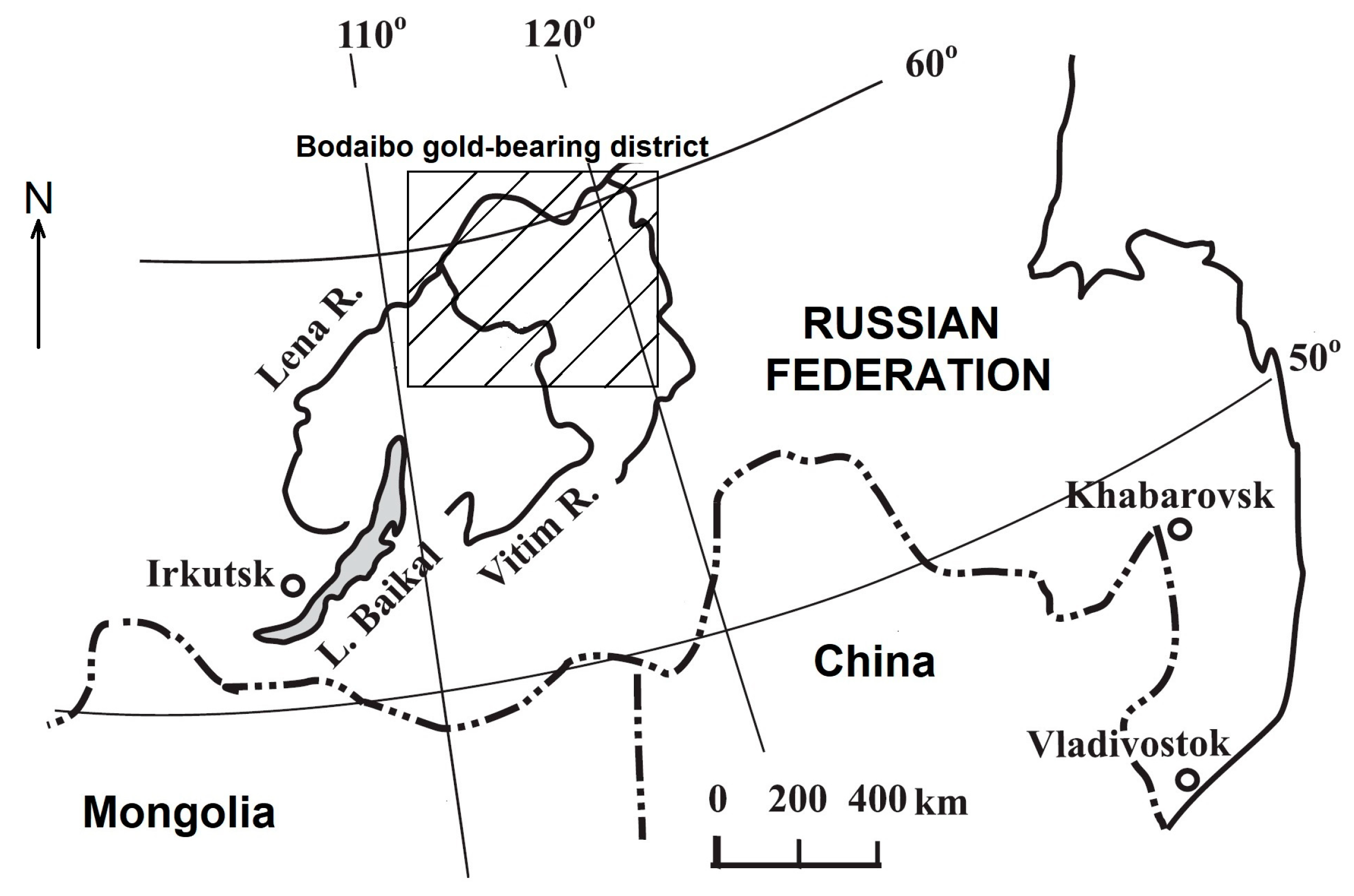
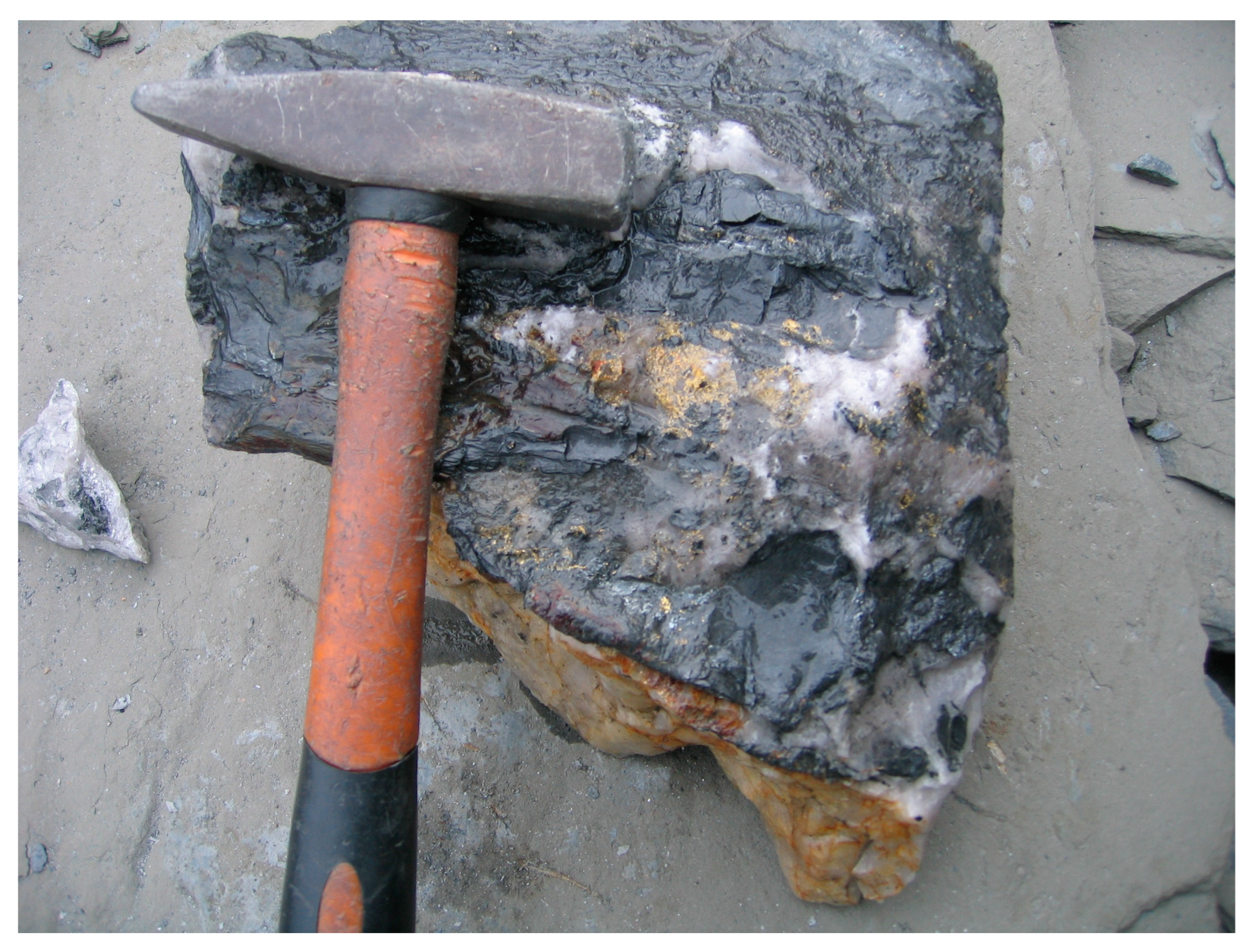

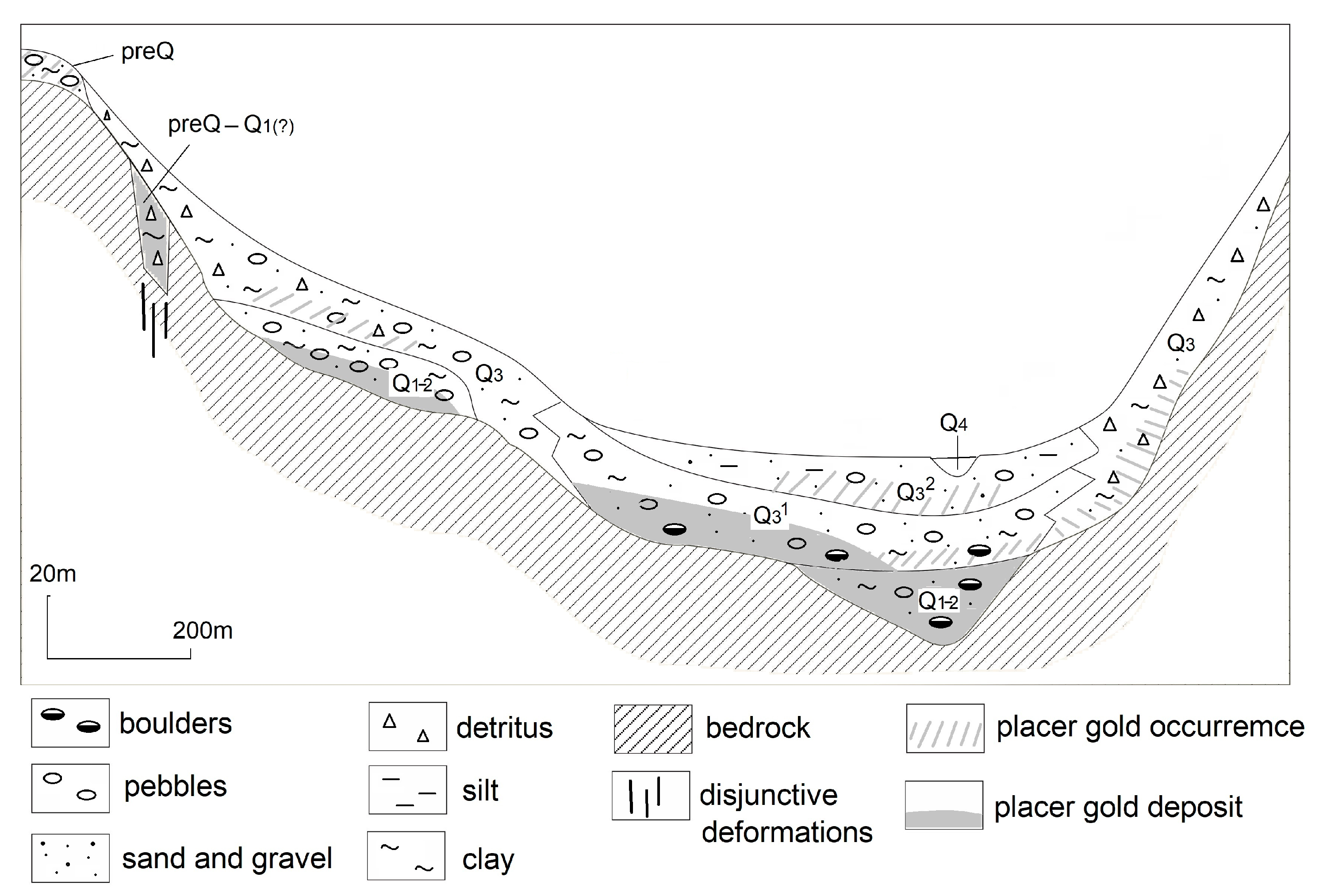

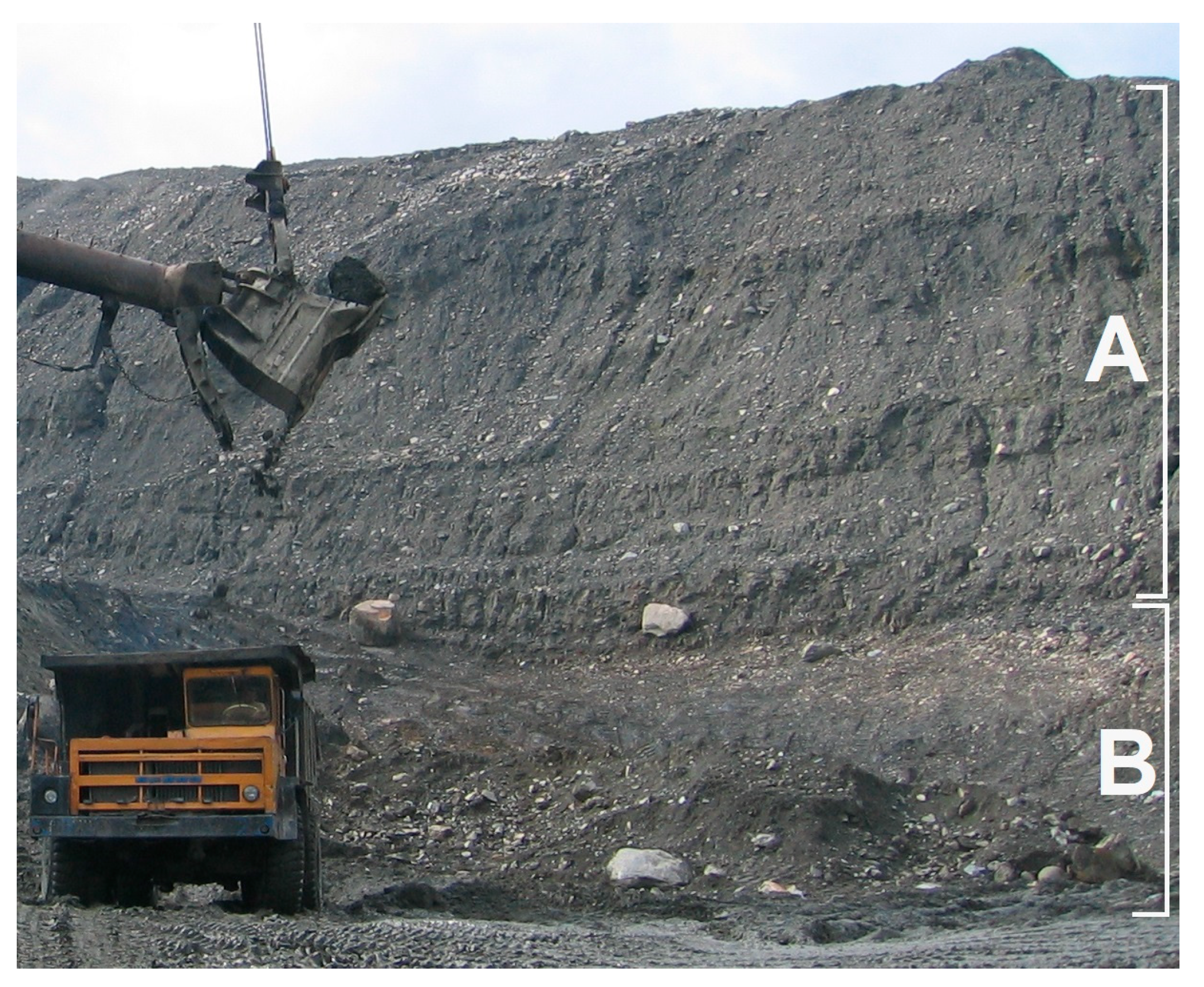
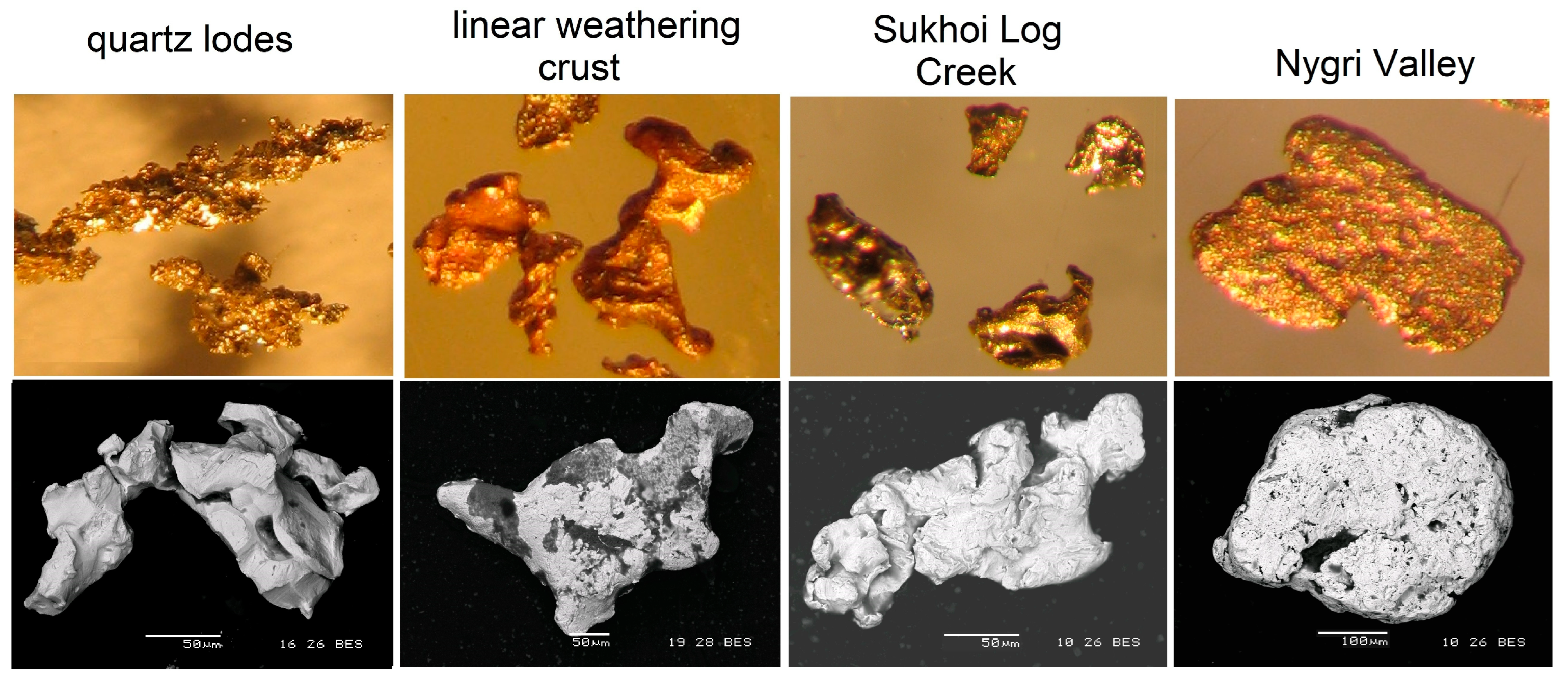
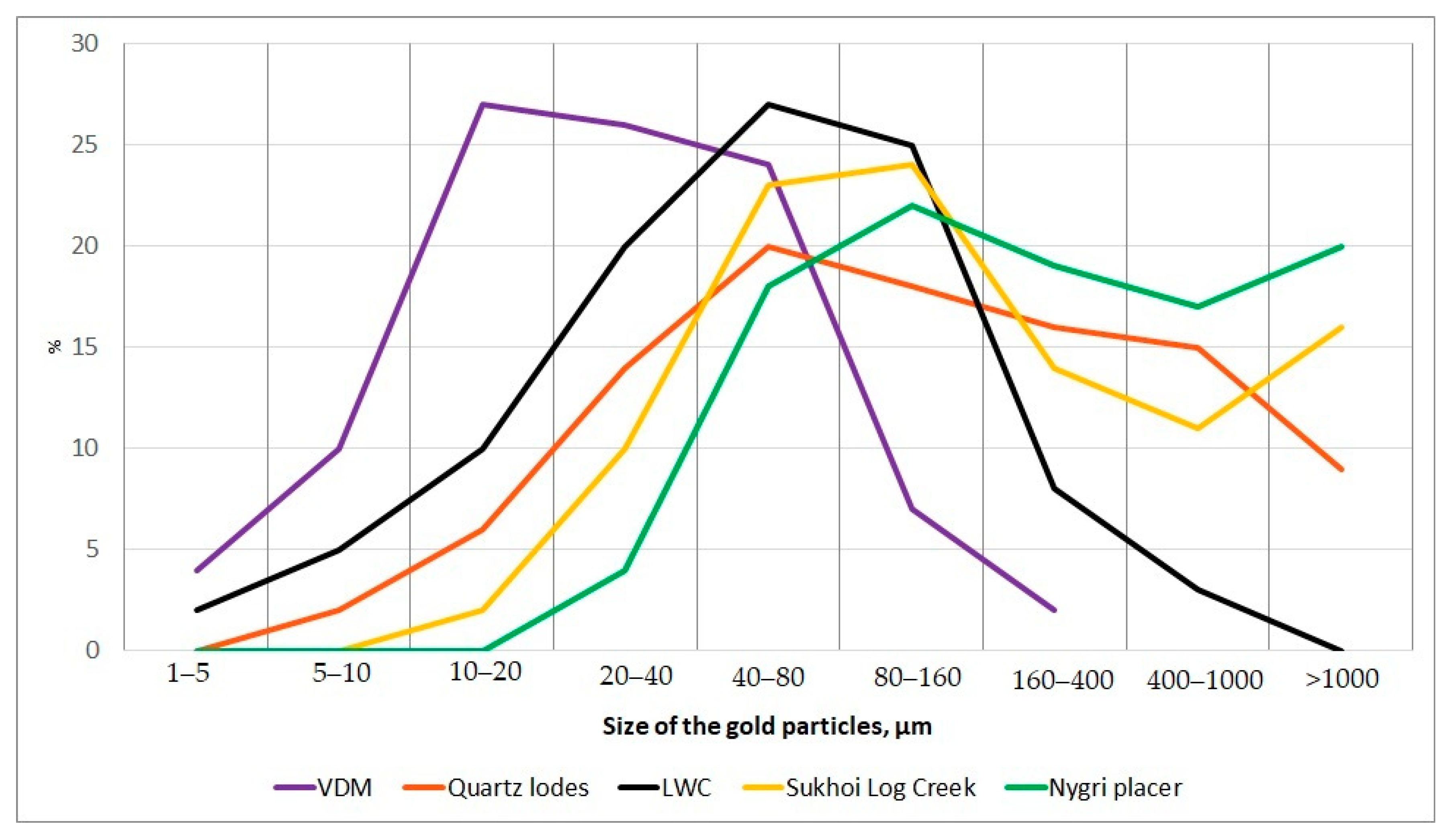
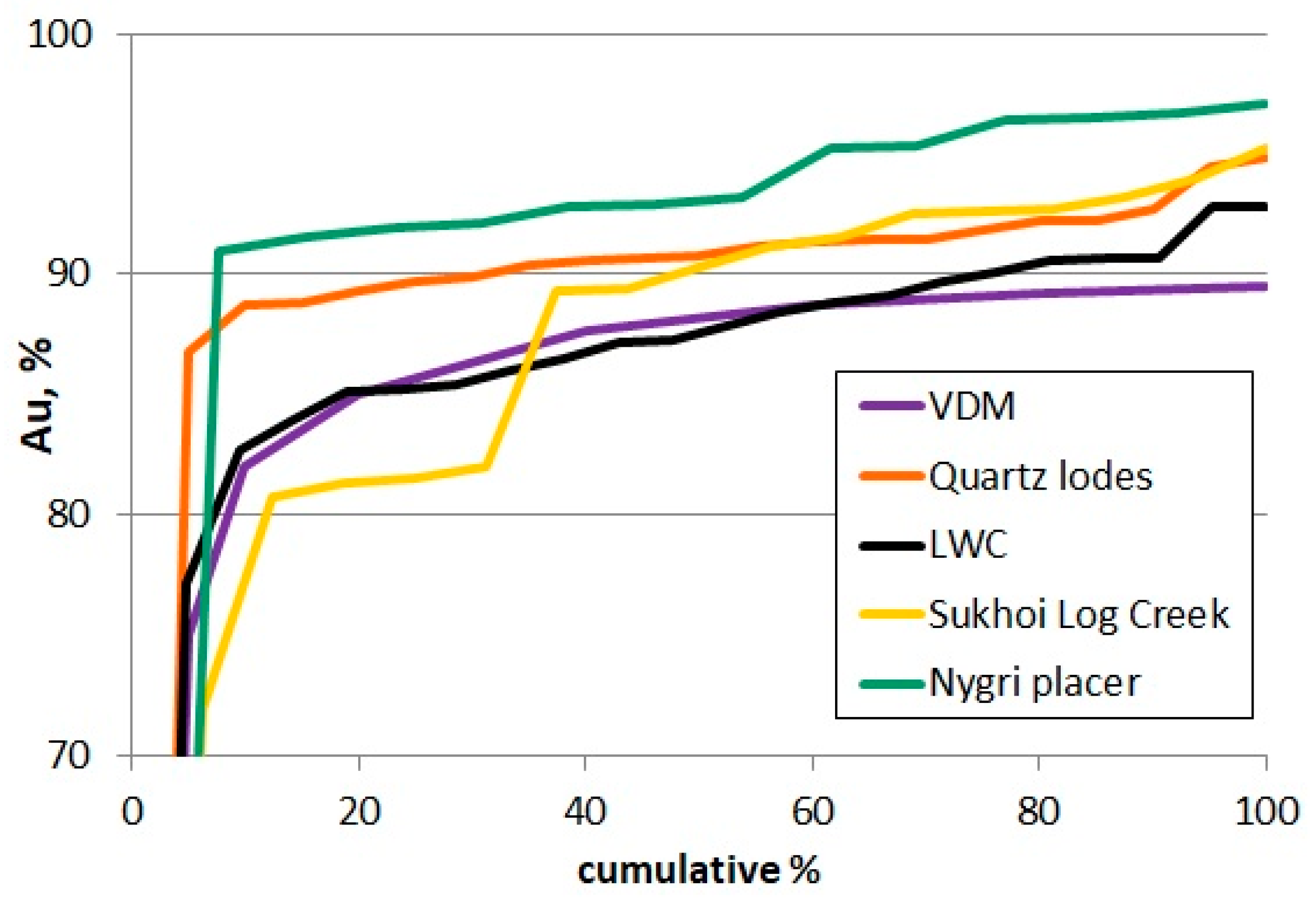
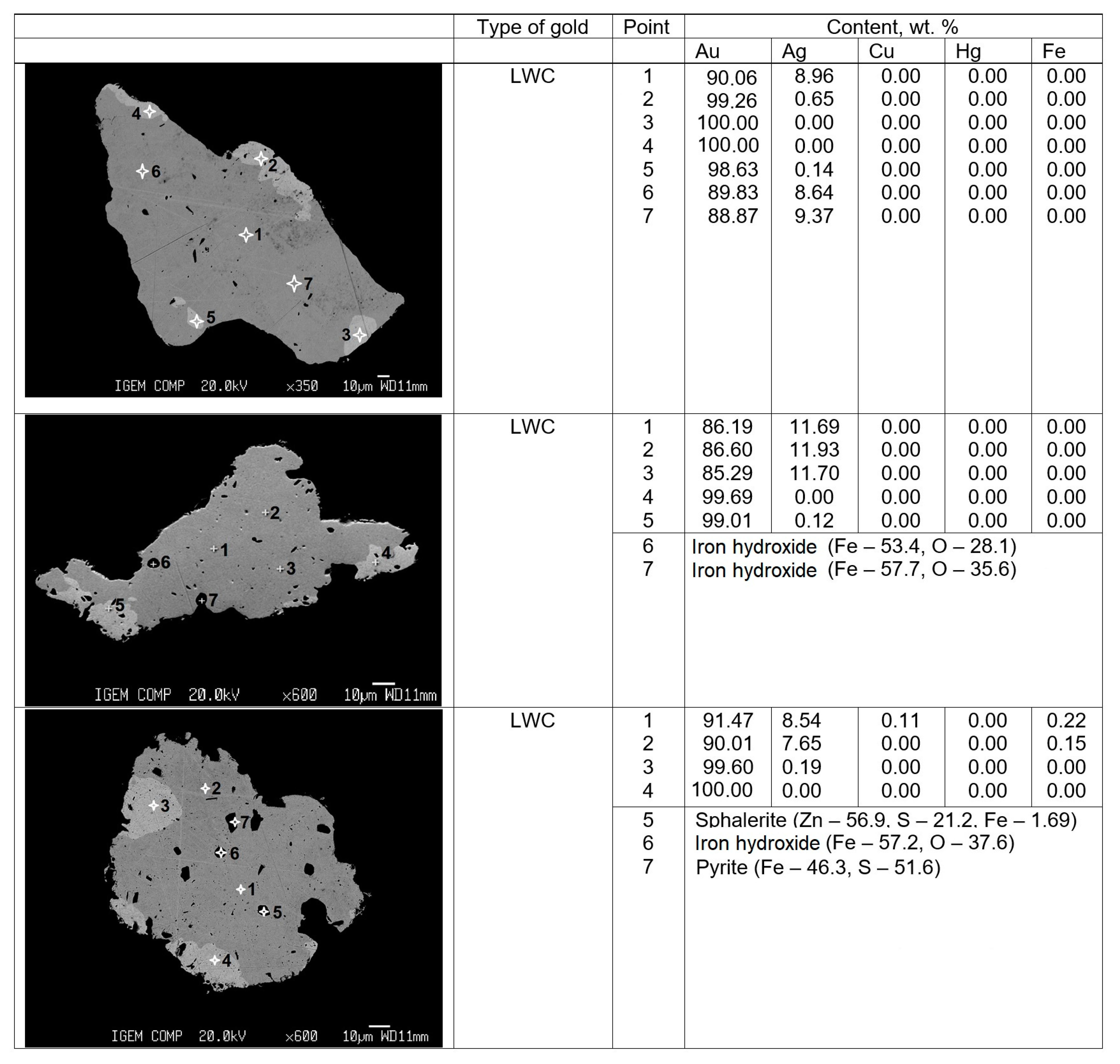

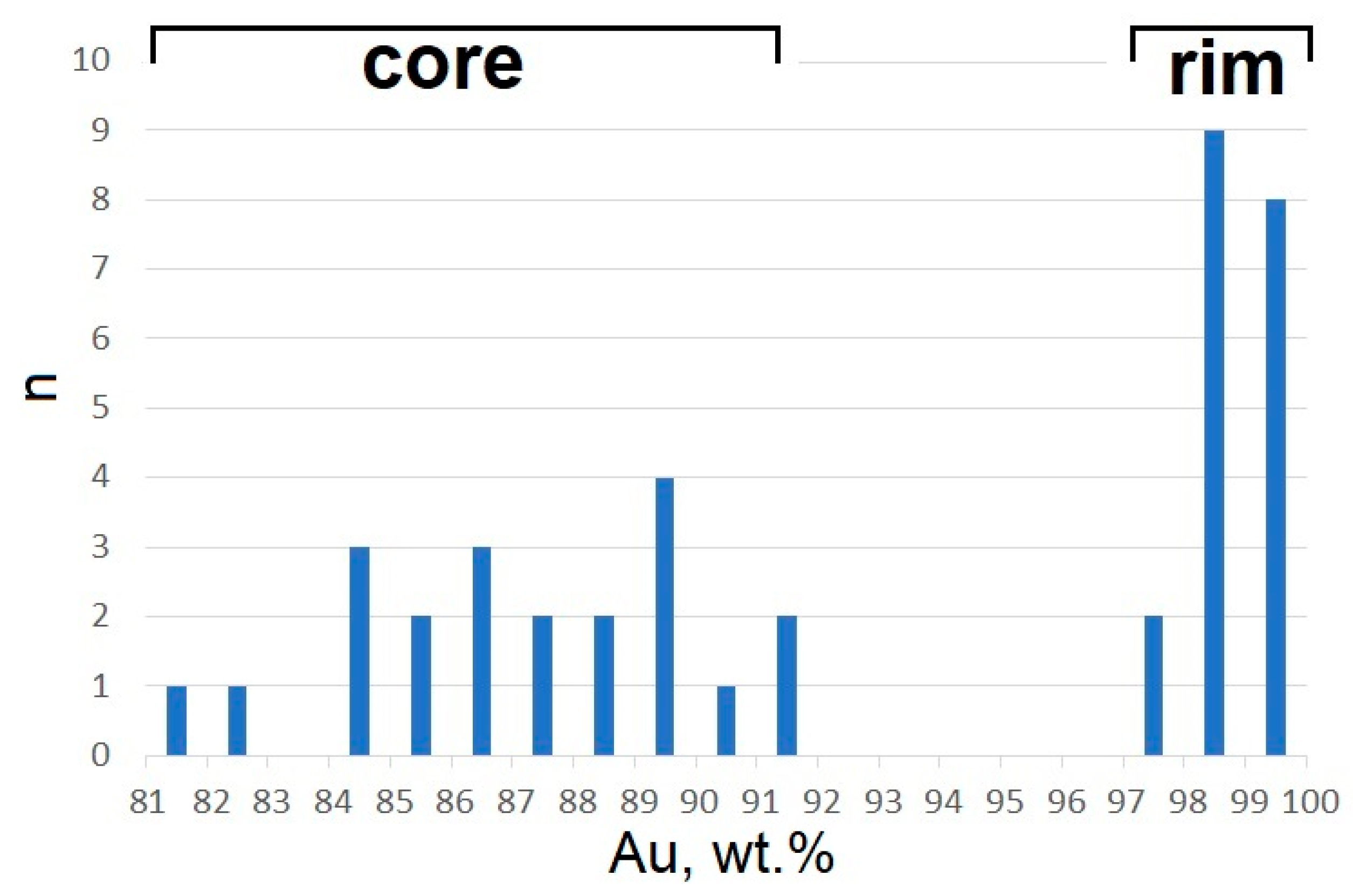
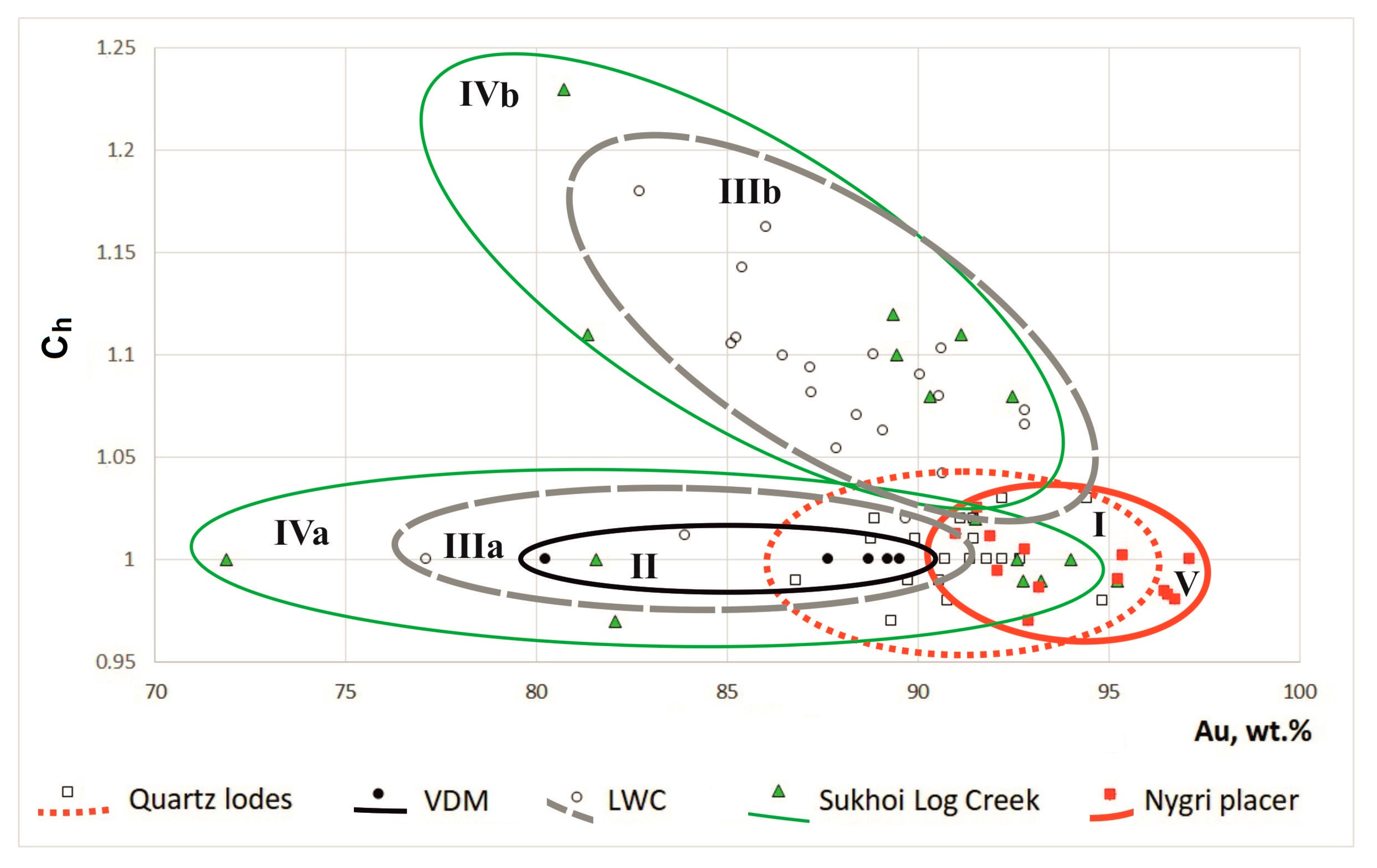
| Ag | Au | Hg | Cu | Fe | |
|---|---|---|---|---|---|
| Accelerating voltage (kV) | 20 | 20 | 20 | 20 | 20 |
| Sample current (nA) | 20 | 20 | 20 | 20 | 20 |
| Beam diameter (μm) | 1 | 1 | 1 | 1 | 1 |
| X-ray | Lα | Lα | Mβ | Kα | Kα |
| Crystal analyser | PETH | LIF | PETH | LIF | LIF |
| Time on peak (s) | 20 | 20 | 20 | 20 | 20 |
| Time on back (s) | 10 | 10 | 10 | 10 | 10 |
| Standard name * | AgSbS2 | Au_s | HgS_s | Cu_s | CuFeS2 |
| D.L. 3σ | 0.04 | 0.33 | 0.11 | 0.07 | 0.07 |
| Size of the Grains (mm) | Fineness in the Core | Ch * | Trace Elements Above Detection Limit, wt.% | |||||
|---|---|---|---|---|---|---|---|---|
| min | max | min | max | min | max | |||
| quartz lodes | variation | 0.01 | >1 | 868 | 949 | 0.97 | 1.03 | Ag (4.5–10.1)—all grains, Cd–1.29 (single), As—0.88 (single) |
| average | 0.37 | 910 | 1.00 | |||||
| VDM | variation | 0.001 | 0.4 | 803 | 895 | - | - | Ag (9.5–14.36)—all grains, Cu (0–0.11), Fe (0–0.97), Hg (0–0.25) |
| average | 0.04 | 870 | 1.00(?) ** | |||||
| LWC | variation | 0.02 | 0.8 | 771 | 928 | 1.00 | 1.18 | Ag (7.2–22.9)—all grains. Cu–0.11 (single), Fe–0.15, 0.22 (two analysis) |
| average | 0.1 | 875 | 1.08 | |||||
| Sukhoi Log Creek | variation | 0.02 | >1 | 719 | 952 | 0.97 | 1.23 | Ag (4.8–28.1)—all grains, Hg–0.18 (single) Fe–0.23 (single) |
| average | 0.48 | 881 | 1.05 | |||||
| Nygri placer | variation | 0.04 | >1 | 910 | 971 | 0.97 | 1.03 | Ag (2.9–9.0)—all grains |
| average | 0.6 | 941 | 1.00 | |||||
Disclaimer/Publisher’s Note: The statements, opinions and data contained in all publications are solely those of the individual author(s) and contributor(s) and not of MDPI and/or the editor(s). MDPI and/or the editor(s) disclaim responsibility for any injury to people or property resulting from any ideas, methods, instructions or products referred to in the content. |
© 2023 by the authors. Licensee MDPI, Basel, Switzerland. This article is an open access article distributed under the terms and conditions of the Creative Commons Attribution (CC BY) license (https://creativecommons.org/licenses/by/4.0/).
Share and Cite
Lalomov, A.; Grigorieva, A.; Kotov, A.; Ivanova, L. Typomorphic Features and Source of Native Gold from the Sykhoi Log Area Placer Deposits, Bodaibo Gold-Bearing District, Siberia, Russia. Minerals 2023, 13, 707. https://doi.org/10.3390/min13050707
Lalomov A, Grigorieva A, Kotov A, Ivanova L. Typomorphic Features and Source of Native Gold from the Sykhoi Log Area Placer Deposits, Bodaibo Gold-Bearing District, Siberia, Russia. Minerals. 2023; 13(5):707. https://doi.org/10.3390/min13050707
Chicago/Turabian StyleLalomov, Alexander, Antonina Grigorieva, Alexei Kotov, and Lidiya Ivanova. 2023. "Typomorphic Features and Source of Native Gold from the Sykhoi Log Area Placer Deposits, Bodaibo Gold-Bearing District, Siberia, Russia" Minerals 13, no. 5: 707. https://doi.org/10.3390/min13050707
APA StyleLalomov, A., Grigorieva, A., Kotov, A., & Ivanova, L. (2023). Typomorphic Features and Source of Native Gold from the Sykhoi Log Area Placer Deposits, Bodaibo Gold-Bearing District, Siberia, Russia. Minerals, 13(5), 707. https://doi.org/10.3390/min13050707





